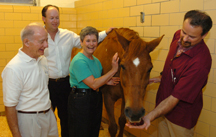
August 27, 2004
Purdue vet school doctors perform two historic procedures on horse
WEST LAFAYETTE, Ind. – Professors at Purdue University School of Veterinary Medicine performed two procedures on a 23-year-old thoroughbred that saved the horse's life and set a precedent for the diagnosis and treatment of a kidney tumor.

|
Jan Hawkins and Laurent Couetil, associate professors of veterinary clinical science, performed an internal ultrasound that required an incision to diagnose a suspected kidney tumor and then removed the horse's right kidney. The professors performed both procedures without general anesthesia on Chico, who is owned by Frank and Janet Daskalos of Zionsville, Ind.
"To our knowledge, this was the first time either procedure has been successfully performed on a horse for the treatment of a tumor in the right kidney," Couetil said.
In horses, the kidneys are not positioned symmetrically, as they are in humans, Couetil said. Because the right kidney is higher than the left, under the rib cage, it might not be adequately diagnosed with an external ultrasound.
"We couldn't image the entire right kidney from outside of the horse because of its position under the rib cage," Couetil said. "So Dr. Hawkins made an eight-inch incision that allowed me to insert the ultrasound probe, under sterile conditions. From the inside, I was able to detect a mass the size of a cherry in the right kidney. We decided it would be best to remove the kidney."
The Daskaloses said they agreed to the surgery to save the life of their beloved horse but were worried about the affects general anesthesia would have on him because of his age.
"I was elated to learn that they could do the surgery without having to put him under general anesthesia," said Janet Daskalos, a biology instructor at Indiana University-Purdue University Indianapolis and Ivy Tech State College.
"I am just so amazed and thrilled with the doctors at Purdue vet school. They saved Chico's life. Some vets would have just said to put him down because he was so old. But the Purdue doctors didn't give up on him."
Because they had never done either procedure, Hawkins and Couetil practiced both procedures on a horse that was destined for euthanasia due to incurable medical problems, Couetil said.
"The internal ultrasound was Dr. Couetil's idea," Hawkins said. "The intra-abdominal ultrasound confirmed our suspicions that there was a tumor. The standing nephrectomy (kidney removal while the horse is awake) has been performed on the right kidney before but not for the treatment of a tumor, to our knowledge.
"We have checked all the literature and don't find a precedent anywhere. The standing procedure we used helps shorten the recovery time because there is no general anesthesia. It's much better for the horse. This should cure him. It's a very successful case so far."
Writer: Reni Winter, (765) 496-3133, rwinter@purdue.edu
Sources: Laurent Couetil, (765) 494-6808, couetil@purdue.edu
Janet Daskalos, (317) 873-0567
Jan Hawkins, (765) 494-8548, hawkinsj@purdue.edu
Purdue News Service: (765) 494-2096; purduenews@purdue.edu
PHOTO CAPTION:
Purdue clinical veterinarian Laurent Couetil feeds an apple to 23-year-old Chico, a thoroughbred that underwent two innovative surgical procedures to diagnose and remove a tumorous kidney. Couetil and fellow Purdue clinician Jan Hawkins, second from left, performed the procedures earlier this week. Chico's owners, Frank and Janet Daskalos, of Zionsville, Ind., look on. (News Service photo/Dave Umberger)
A publication-quality photo is available at https://ftp.purdue.edu/pub/uns/+2004/hawkins-horse.jpg
To the News Service home page